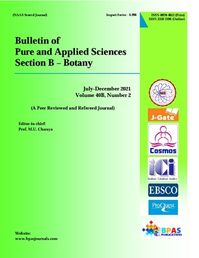Quantitative Analysis of Phytochemical Compounds in the Cotton (Gossypium) Seed Extracts; an Important Commercial Crop Plant
DOI:
https://doi.org/10.48165/Keywords:
Cotton (Gossypium), Phytochemicals, Quantitative analysis, Commercial Crop PlantAbstract
Almost all the parts of the plant viz., bark, root, stem and seeds are known to have various medicinal properties. The trend of using natural products has increased and the active plant extracts are frequently screened for new drug discoveries and for the presence of antimicrobials. According to the world health organization, medicinal plants would be the best source to obtain a variety of drugs. Therefore, such plants should be investigated to better understand their properties, safety and efficiency. In the present study the cotton plant was selected to determine the yield of phytochemicals quantitatively from the crude extracts of seeds. Cotton belongs to the family Malvaceae, genus Gossypium; popularly known as white gold is an important commercial crop in India. The plant has been found to possess several ethno medicinal uses. Scientific investigations have shown that cotton roots and seeds contain certain compounds that may be beneficial to the health, potentially for treating Cancer and HIV. The seed extracts were prepared by using acetone, chloroform, ethanol, ethyl acetate, methanol, petroleum ether and water. The yield of phytochemicals were calculated as weight/weight in all the seven solvents and are studied for seven phytochemical compounds. The maximum numbers of phytochemical compounds are soluble in methanol and ethyl acetate. Results revealed the presence of alkaloids, flavanoids, total phenols, tannins, saponins, terpenoids and glycosides in varying content; among the seven phytochemicals phenols are abundantly presents in cotton seed.
Downloads
References
Chakraborthy and Brantmer, (1999), Phytochemical analysis of medicinal plants, Journal of Phyto Chemistry, ISSN: 2348, 17, pp: 234-246.
Chandrashekar R, Jyothi chaitanya P and Lakshmi Bhavani N, (2013 a), Gossypol analysis in Bt and non-Bt cotton seed extracts by High-Performance Liquid Chromatography (HPLC)’, International Journal of Herbal Medicine, Volume: 1, Issue: 2, pp: 53-58.
Chandrashekar R, Jyothichaitanya P and Lakshmi Bhavani N, (2013 b), Isolation of gossypol and analysis of phytochemicals in seed extract of Bt and non-Bt varieties of cotton, Indian Journal of Pharmacognosy and Phytochemistry, 2278-4136,Volume-2, Issue 1,pp: 180-186. 4. Current Cotton Scenario, 2017 (http:// Cotcorp.gov.in/statistics.aspx).
Das and Ventachalm (1999), Trend of using natural products from active plant extracts for new drug discoveries, Journal of International Phyochemistry,2135, 19, pp: 204-217. 6. Farnsworth, N.R. and R.W. Morris, (1976). Higher plants, The sleeping Giant of Drug Development. Am. J. Pharm., 148, pp: 46-52.
Feroz, M., R. Ahmad., S.T.A.K. Sindhu and A.M. Shahbaz, (1993). Antifungal activities of saponin from indigenous plant roots. Pak. Vet. J., 13, pp: 44.
Gupta RK, (2010). Medicinal and Aromatic plants, CBS publishers and distributors, 1st Edition, 2010, pp: 116-117.
Hamburger and Hostettman, (1991), Bioactivity in plants: the link between phytochemistry and medicine, Phytochemistry 30, pp: 3864-3874.
Harborne, J.B., (1985). Phytochemical methods. Brittonia, 37: 309, pp: 1315-1319. 11. Krishnaiah, D., T. Devi, A. Bono and R. Sarbatly, (2009). Studies on phytochemical constituents of six Malaysian medicinal plants. J. Med. Plants. Res. 3(2), pp: 67-72.
Mendonca-filho (2006), Bioactive compounds: New approaches in the phytoscience. In: modern phytomedicine- Turning medicinal plants in to drugs.
Obdoni B and Ochuko P. (2001). Phytochemical studies and comparative efficacy of the crude extracts of some homostatic plants in Edo and Delta States of Nigeria. Global J. Pure Appl. Sci; 8, pp: 203–208.
